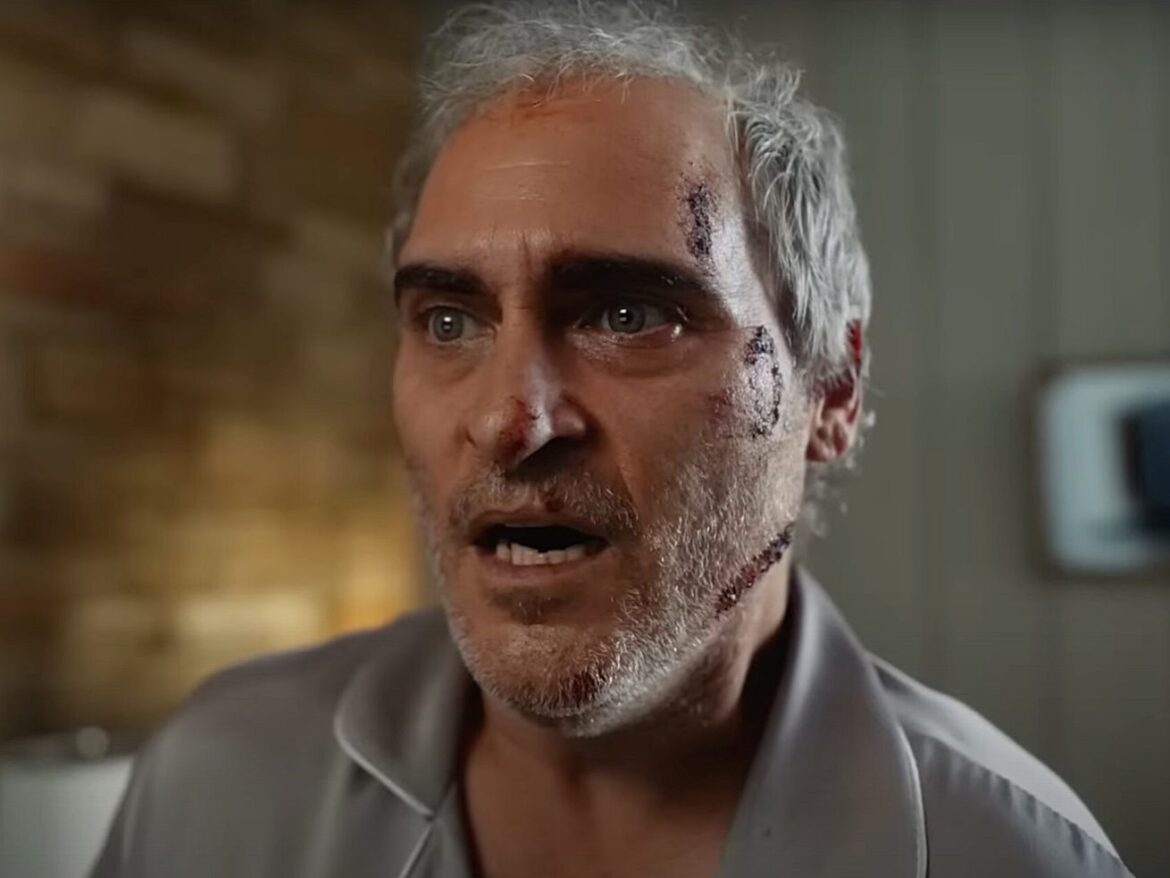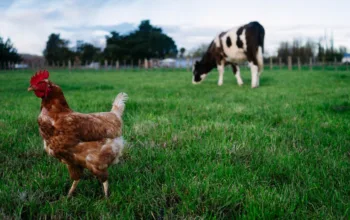The director of the new Joaquin Phoenix film on animation, nightmares, and all those signs.
Asking Ari Aster to explain his movies is not a winning proposition, and thank goodness. The director of Hereditary and Midsommar works highly intuitively, and that shows up on the screen. While his films seem to beg for a close reading — take, for example, all the many bizarre and hilarious signs in the background of his latest film, Beau Is Afraid — ultimately, they tend to defy explanation.
That makes his films less locked to one way of thinking about them, less obviously “about” one thing in particular. Audiences get the chance to feel their way through his movies, just as Aster does when he makes them. You can take away your own ideas and discomforts and revelations from Beau Is Afraid, and they might not be the same as anyone else’s, and that’s just fine.
Nevertheless, it’s fun to talk to Aster, who is deliberate and insightful about his own working process. Shortly before the film’s release, he and I spoke about how he designed some of the movie’s more comical and whimsical elements, what he’s trying to do when he makes a movie, and one little key to understanding Beau.
This interview has been edited and condensed for clarity.
Midsommar fans keep asking me about this movie. The way I describe it is that, whereas Midsommar is an inversion of a Disney Princess fantasy, this is an inverted, twisted hero’s odyssey. Did it start off being that kind of story?
It was always something of a risk, playing with the hero’s journey. But it’s also a film that’s about an unlived life. It’s set in this cartoon world that should function as a mirror of the world we’re in. It’s awful in all the ways that the world is awful, but with the dial turned just a little bit higher.
The trick was to make Beau very real. He’s our surrogate. He is who we have to hold on to. The challenge was, how do I make that experience incredibly visceral and immersive, and then at the same time, put him in this world that is just endlessly malign?
/cdn.vox-cdn.com/uploads/chorus_asset/file/24583026/beau4.jpg)
A24
That’s part of what’s so stressful and good about it. It honestly mirrored some of my most banal but aggravating recurring dreams, and that made it even more tense. I have a recurring nightmare where I need to go somewhere, and everyone I encounter is keeping me from getting there. I have nightmares about everything I do in life being projected in front of the whole world. The fantasy that everyone’s mad at me. These are all very common, boring things that everyone encounters, and yet they are the world as it exists to Beau. Right?
Yeah. It was very liberating to just have this invented world that allowed me to go wherever my intuition led me. If some very stupid idea made me laugh, the challenge was to find a way to get it in there and have it be cohesive with the whole. But there was nothing too crazy, too stupid, too strange. That was just fun.
It felt like one guy’s nightmare that just kept getting worse.
Hopefully, it’s not a pile-on. I tried to shape it so that there were these respites, where the nature of the film would keep changing. Again, it’s tricky, because you hope that all those pieces are in harmony with each other. But with a film like this, you’re really, really clinging to your intuition.
And nightmares are funny — when you’re not having them.
Yes, that’s right.
/cdn.vox-cdn.com/uploads/chorus_asset/file/8635113/spoilers_below.png)
The character of Beau is extremely passive, the kind of guy who, if you accuse him of doing something, he probably assumes he deserves it. He’s afraid of not following the rules. A revealing detail for me is that he’s trying to leave his apartment, but what he goes back for is … dental floss.
Well, I’ll say this. If you pay close attention, you’ll see that he almost takes the dental floss when he is packing his bag. He stopped. He hesitates, holding the floss, and then takes something else, and then goes back for the floss. I think there’s a key there.
The movie is so obviously about guilt that it’s not even worth saying that. It’s about a guy who’s really trapped in himself, really, really, really trapped. I’m somebody with a lot of ambivalence. Ambivalence is a very particular kind of hell.
I really, really want to avoid saying much because I really feel that if you can get on its wavelength, then it’s … it’s a movie that I felt my way through. I have a feeling that’s the only way to watch it as well.
/cdn.vox-cdn.com/uploads/chorus_asset/file/24583235/1481290771.jpg)
Robin L Marshall/FilmMagic
My favorite part of the movie might be the massive amount of signage throughout: the graffiti, the posters in the bedroom, there are signs everywhere. My favorite is that there’s a notice about a brown recluse in the building taped to everybody’s door in Beau’s apartment complex, and on the bottom of the sign is a quote from Winston Churchill: “The price of greatness is responsibility.”
Oh, you got that, great. There’s always a sadness in me thinking about all those details that will never be noticed. You’re the first person who caught that. That Churchill quote really makes me laugh. It’s the stupidest.
That was part of the fun of creating this world. I wanted to make sure that every billboard, every poster, every product, every newspaper was made from scratch, and was made in the spirit of the world: evil comedy. All the comic details.
There’s this term that was coined by Will Elder, from Mad magazine: chicken fat. It’s the overabundance of background gags that have been crammed into any given panel. I wanted there to be a lot of chicken fat here. I spent a long time building out a list of stupid names and names that made me laugh.
These are things that nobody will know that just made me laugh. Like the city that Beau lives in, in the first part of the film, is called Corrina, Corrina. The city is Corrina. The state is Corrina. That’s a reference to a Whoopi Goldberg and Ray Liotta film from the ’90s.
Ha! My friends and I were debating about where that actually was supposed to be.
He lives in Corrina, Corrina. And then he goes to Wasserton at the end, the home of Mona Wassermann.
That was a very joyful part of the process. Fiona Crombie was the production designer. She was a joy to work with. It was very fun making sure that the world was dense with detail.
/cdn.vox-cdn.com/uploads/chorus_asset/file/24583027/beau7.jpg)
A24
I couldn’t stop giggling at the poster in the teenage daughter’s bedroom that has the faces of all the K-pop stars, and the band is called “Ki55,” and the tagline is “We are 55 boys and we love you.” And both times I’ve seen it, the whole audience lost it when Beau walks up to his mother’s house and sees the caterer’s van with “Shiva Steve’s Grub For The Grieved” on the back of it.
There are also those signs nailed to trees as Beau is walking into the woods to meet the theater troupe. They have uplifting slogans about following your dreams and are from musicals, right?
Those are all lyrics from Broadway musicals and plays. I found that fun that it starts with “Know Thyself,” and then every sign gets dumber and dumber, so it’s all platitude lyrics.
It took me till the second viewing to realize that Beau’s defense lawyer at the end is standing beneath a sign that says 1-800-DEFENCE on it.
Well, yeah. They clearly just couldn’t get all the numbers they needed.
Let’s talk about the animated “Hero Beau” sequence. How did that come into being?
That’s a sequence in which Beau enters a play. He’s hypnotized, and he enters the play in his mind. We knew that there was going to be a lot of stagecraft involved; that was the original idea. Then I realized that I wanted it to be animated as well, or I wanted there to be animated elements that were interacting with the stagecraft.
I was really obsessed with this stop-motion monstrosity called La Casa Lobo by Cristobal Leon and Joaquin Cocina. These Chilean animators were so brilliant. I reached out to them to see if they would want to collaborate. I had already shotlisted and storyboarded the sequence, but it became very clear, pretty early on, that not only should they do all the animation, but because that would be interacting with the stagecraft, they should also be the ones to develop the look of the flats and the sets. We spent a long time in development on that, finding an aesthetic that did not clash with the rest of the film.
I think I drove them nuts, but it was a lot of fun. I’d love to work with them again.
/cdn.vox-cdn.com/uploads/chorus_asset/file/24583031/beau.jpg)
A24
We also enlisted the help of an animation producer, a supervisor, to keep everything organized and on track, and make sure that that was always growing as we were making the rest of the film, because it needed constant attention. His name is Jorge Canada Escorihuela. He was really just essential to that getting made in that way and in the right way. He just understood so well what we were doing and kept that train on the tracks. I love him so much, and I know that Cristobal and Joaquin love him. He really, really was so committed to this. He gave it his whole life. It really was a huge undertaking, to be managing that while we were building out all the other worlds. Every shot of that sequence was a world that we not only had to animate later, but we had to build it and shoot it on a stage. So just getting all of that built was a lot.
When the animated sequence started, I scribbled down “dream ballet?” because it reminded me of those very Freudian dream ballets that pop up in the middle of musicals from the ’50s and ’60s. Sometimes they reveal the desires of the main character or retell the story in these mythic terms. Was that where this sequence came from?
Well, The Red Shoes certainly came to mind. I know that I sent the guys The Ballad of Narayama, because that is so drawn from kabuki techniques and the artifice is so extreme. What else? We were talking about Karel Zeman, especially Invention for Destruction. We were hoping also just to find a look that was its own.
Something great about this movie, I think, is that it runs against the tendency of contemporary moviegoers to demand that things be puzzles to be solved or mysteries that can be unlocked.
I agree.
With this, it’s about feelings. The pieces are not there to be fitted together into a puzzle.
No. If anything, the movie’s like an echo chamber. It’s sort of like a hall of mirrors. I want to encourage a deep engagement with it. I want you to search the movie because there’s a lot that I’ve buried as well, and a lot that I think I imagine will make itself much more clear upon a second viewing, just by knowing where it goes, to watch it again and see, “Oh, right. I guess this is a motif.”
I don’t know how obvious those things are or if I was able to bury them into the fabric so that it’s not just … there. I think the movie very much just is what it is.
Beau Is Afraid opens in limited theaters on April 13 and wide on April 20.



